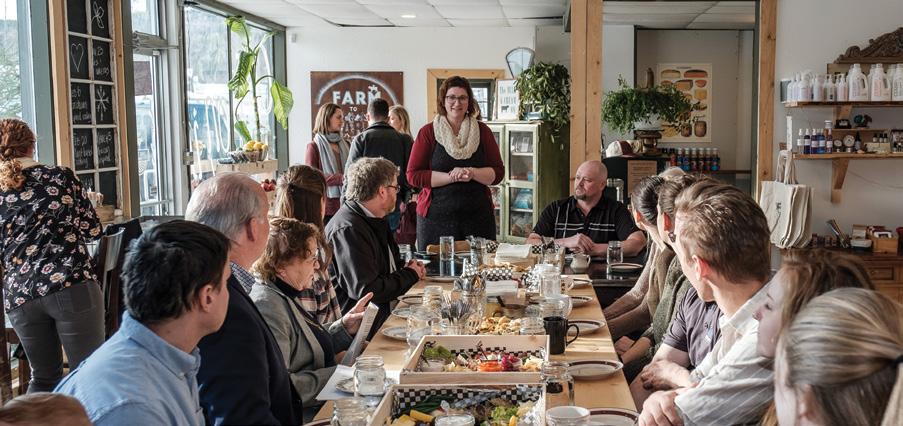
7 minute read
No Time Left to Waste: Soil Health
Soil Health
Article by Oliver Berger
Advertisement
We are slowly beginning to understand the value of treating the life under the surface of the ground we walk on with a bit more respect.
In late January, the Young Agrarians along with the Cattlemen’s Association held a seminar at Thompson’s River University, Williams Lake Campus with this exact topic in mind: soil health.
At a balmy -30 degrees C outside there was a great turnout. Farmers, ranchers, composters, and eager soil geeks from around the region gathered to soak up everything we could. Speakers came from across British Columbia, Manitoba, and even the United States to share with us.
I was expecting most of the talk to focus on general ranching practices and farming techniques; however, to my delight this seminar focused completely on its title subject—Building Soil Health—and explaining its direct connection to farming and ranching. By focusing more of our energy on what is beneath the surface as opposed to what we see growing above it, we can completely regenerate our soil and reap more benefits than we ever thought.
The main speaker, Dr. Kris Nichols, started us off explaining soil microbiology to provide deep descriptions of how to regenerate soils. Many interactions take place underground, especially with the assistance of mycorrhizal fungi, a key element in making soil. The fungi are a relationship builder, carrying nutrients and bacteria between plants, roots, and water. We have all heard how tree roots speak with each other through fungi.Well, it turns out all root systems can work the same way.
“The biggest thing lacking for farming and ranching is your soil,” said Nichols. “It determines your limitations.” He reminded us to get out of our heads and think of new approaches instead of relying on traditional styles. We learned to treat soil like we treat ourselves: if we only eat one type of food— like doughnuts, let’s say—how will our bodies react and grow? We learned it is important to feed our soil year round, supply it with a diverse diet, protect it from the extremes, and, just as we stress our bodies with exercise to build muscle, push some limits on our fields to build strength in our soils.
Simply put, all organic matter created on agricultural land should never leave the site. Living and breathing plants capture much of the carbon in our atmosphere. They use that carbon to build their plant structures while all the excess is pushed through their roots and stored in our soil. The more organic matter in the soil the easier it is for the carbon to be captured underground. Microbes thrive in this type of carbon-rich environment, which in turn makes nitrogen more readily available for your plants. Cha-ching!
Most often when nitrogen fertilizers are applied, the plant is not ready for that much uptake and may only absorb 30–50 percent. The excess runs off into our watersheds and evaporates into our atmosphere. Nitrous oxide is almost 300 times more potent than CO2 and has an atmosphere lifetime of ~121 years. Studies have shown that we use more synthetic nitrogen to produce a bushel of corn today than we did in 1960. Yes, yields have gone up; however, nitrogen-use efficiency has decreased. The soils need our help—it needs our carbon.
Every time we till the land, turn the soil, or cut down trees we expose the existing carbon in the ground to the air, releasing CO2. Carbon is the skeleton of what is beneath our feet, and we have been taking that skeleton apart, bone by bone, and putting it in the atmosphere.
Photo: www.123rf.com, Copyright: Orlando Rosu
We must focus on carbon sequestration (aka: photosynthesis) in our gardens and our agricultural practices.
The term ‘brown revolution’ was noted during the seminar. The benefit of using carbon in our fields and sequestering it through our plants in the agricultural world is growing. Protecting the ground from exposure, reducing tillage, managing livestock effectively, reducing synthetic fertilizers, diversifying crops, and maximizing photosynthesis have all produced positive results in building soil health.
Regenerative farming, as it is also called, could offset a massive portion of our CO2 emissions. Almost 40 percent of the earth’s surface is used for farming—imagine if all that land sequestered carbon more efficiently. We can change the system while all together improving soil health, increasing soil porosity, protecting against flooding, creating more jobs, growing more nutritious food, and improving our relationship with the land.
Now I wonder if anyone else noticed all the potential carbon in this garbage can… -GG
Oliver Berger has a 38-year degree in life, starting out in the Spokin Lake area, spending adolescence in Williams Lake, and then venturing throughout the world on a quest of always learning new things. His priorities include dedication to and education about waste management.
Sprout Kitchen Project Manager Amy Quarry speaking at a round table with local food businesses and farmers during Premier John Horgan’s visit to Quesnel in January 2020. Photo: BC Government

You’ll Grow Really Well Here Sprout Kitchen: Regional Food Hub and Business Incubator Set to Launch this Fall
Growers and food producers from Vanderhoof to One Hundred Mile House are experiencing the exciting growth of the local foods industry with the development of Sprout Kitchen Regional Food Hub and Business Incubator. In July 2019, the City of Quesnel was awarded $500,000 from the Ministry of Agriculture to develop a small-scale food processing and innovation centre based in Quesnel. Launching in the fall of 2020, Sprout Kitchen will be a small-scale food processing and innovation hub that serves the area from Vanderhoof to One Hundred Mile House.
While there is consumer demand to buy and eat locally produced, value-added food products, a gap exists in getting small food businesses into grocery stores, restaurants, and larger markets. To address this gap, the BC Ministry of Agriculture is supporting the development of a series of regional Food Hubs that will link food producers and processors with shared technology, research and development, production equipment, expertise, and services.
Food hubs are a crucial but often invisible part of the local food system. They help small farms grow by offering a combination of production, distribution, and marketing services. There are now 236 food hubs in the United States, with more popping up all the time. Some are physical spaces, some virtual online spaces, but all are concerned
By Diandra Oliver
with connecting the dots between producers and consumers of food in local and regional food systems. Food hubs can be thought of as community-based supporters that connect producers (farmers and ranchers) with institutional buyers (restaurants, hospitals, schools, etc) and end consumers.
Since the word ‘food hub’ can be used to describe a variety of initiatives, Sprout Kitchen Project Manager Amy Quarry explains, “this particular type of food hub is a commercial food processing hub that is designed to support the development of value-added food products and businesses. This includes the marketing of regional agricultural crops, simplifying the local food supply chain, and making and selling food products that could be sold in grocery stores, restaurants, and to regional infrastructure like schools and hospitals.”
Once open, Sprout Kitchen will operate a centralized shared-use food and beverage processing facility in Quesnel that will provide new and established business owners with easy and affordable access to shared processing infrastructure including processing and testing equipment, food business advisory services, product development services, analytic services, applied research opportunities, and education and training related to food processing and food safety.
For Chanelle Sankey and Sarah Murray, owners of Hixon Falls Cracker Co., Sprout Kitchen is arriving at the right time. Sankey says, “We both have always envisioned opening our own food business, and since the idea of Sprout Kitchen has been introduced to our community, it’s given us the aspiration to push ourselves to expand and improve our business.”
By having the opportunity to be in a larger processing facility and connecting to new markets and services Sankey and Murray will be able to increase their production and product development with access to the proper equipment and guidance.
“Getting involved in this project and meeting new contacts and networking with experienced people in this industry will support us to essentially learn more and grow our business,” says Murray.
Sprout Kitchen is an initiative of the City of Quesnel with generous support from the BC Ministry of Agriculture and Northern Development Initiative Trust. To learn more about Sprout Kitchen and how you can get involved, please visit www.sproutkitchen.ca or email info@ sproutkitchen.ca. -GG







